A State-by-State Guide
Wind Severance Laws
Most states don’t expressly allow you to carve out wind rights, and a handful have passed anti-severance laws to keep wind tied to the surface estate.
Sell Your Wind Rights (Request an Offer):
The Bottom Line
States Prohibiting Wind Severance
Based on current legal statutes, the following eight states have enacted anti-severance laws that prohibit the separation of wind rights from the surface estate. These statutes prevent the fragmentation of wind rights, ensuring that wind energy development remains tied to the surface estate.

Colorado
Wind rights must remain attached to the surface estate under Colorado law, with no option for permanent severance.

Kansas

Oklahoma

North Dakota

South Dakota
South Dakota law prohibits wind severance and voids agreements after five years if development hasn’t begun.

Nebraska

Montana

Wyoming

Exception: Texas
Texas does not have a statute banning severance and a recent case opened the door for wind severance.
Disclaimer: This summary is provided for general informational purposes only and does not constitute legal advice. Blue Mesa Minerals is not a law firm and does not provide legal advice. Always consult a licensed attorney in your state before making legal decisions regarding wind rights or severance laws.
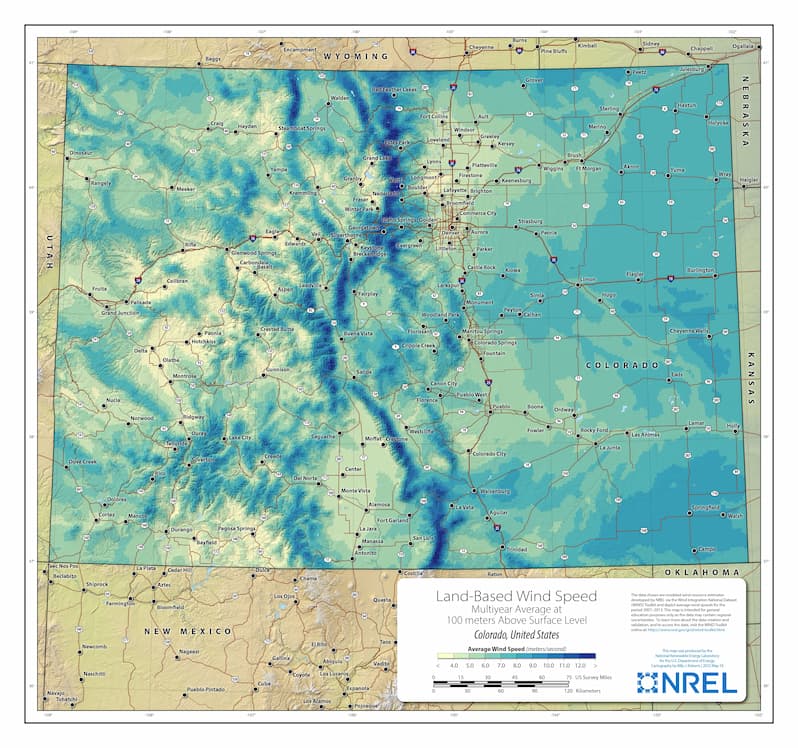
One of the First
Colorado
Colorado was one of the earliest states to formalize wind energy development laws, including a clear prohibition on severing wind rights from the surface estate. The statute requires wind rights to remain tied to the land, limiting speculation and reinforcing the landowner’s control. However, some legal scholars note that the statute’s silence on enforcement mechanisms leaves room for uncertainty in practice.
The Colorado Revised Statutes, specifically in C.R.S. § 38-30.7-103(1) states:
A wind energy right is not severable from the surface estate but, like other rights to use the surface estate, may be created, transferred, encumbered, or modified by agreement.
Definition of Wind Energy Right
A wind energy right refers to the ability of a surface estate owner, or a wind energy developer under agreement, to capture and utilize the kinetic energy of the wind.
Wind Energy Agreements
While wind rights cannot be severed, they can be utilized through agreements such as leases, licenses, or easements between the surface owner and a wind energy developer. These agreements must be recorded with the county clerk and recorder to be enforceable against third parties.
Termination and Release
Upon expiration or termination of a wind energy agreement, the developer is required to record a release of the agreement. Failure to do so within 90 days after a request from the surface owner can result in the developer being liable for any damages caused by the failure.
Expiration of Rights
If a wind energy agreement does not specify an expiration date, it automatically expires 15 years after its recording unless construction of wind energy facilities has commenced. An affidavit stating the commencement date can be recorded to extend the agreement’s validity.
Grandfathering of Preexisting Rights
Agreements or conveyances made prior to July 1, 2012, are not altered by these statutes. However, to maintain their validity, such agreements must have been recorded by September 1, 2012.
Disclaimer: This overview of Colorado law is for informational purposes only and is not legal advice.
Wind & Solar Rights Impacted
Kansas
Kansas has one of the most structured anti-severance statutes in the country. It explicitly bans severing both wind and solar rights and requires any energy development agreement to include detailed specifications like vertical angles and termination conditions. The law reflects Kansas’s intent to avoid the fragmentation seen in mineral rights — creating a cleaner, more developer-friendly title environment and easier pay process.
Kansas Statutes, specifically in K.S.A. § 58-2272(b), states:
No person other than the surface owner of a tract of land shall have the right to use such land for the production of wind or solar generated energy unless granted such right by the lawful owner of the surface estate by lease or easement for a definite period.
Grandfathering of Preexisting Rights
Leases or easements filed of record prior to July 1, 2011, are not subject to the non-severability requirement and remain valid.
Required Elements in Conveyance Instruments
Any instrument conveying an interest involving wind or solar resources must include:
- A description of the real property subject to and benefiting from the easement or lease.
- A description of the vertical and horizontal angles, expressed in degrees, and distances from the site of the wind or solar power system in which an obstruction is prohibited or limited.
- All terms or conditions under which the lease or easement is granted or may be terminated.
- Any other provisions necessary or desirable to execute the instrument.
Disclaimer: This overview of Kansas law is for informational purposes only and is not legal advice.
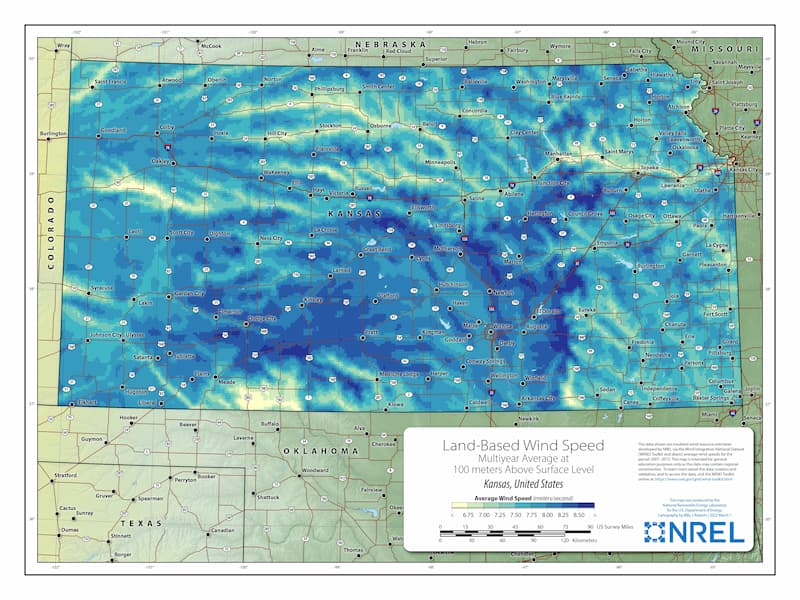
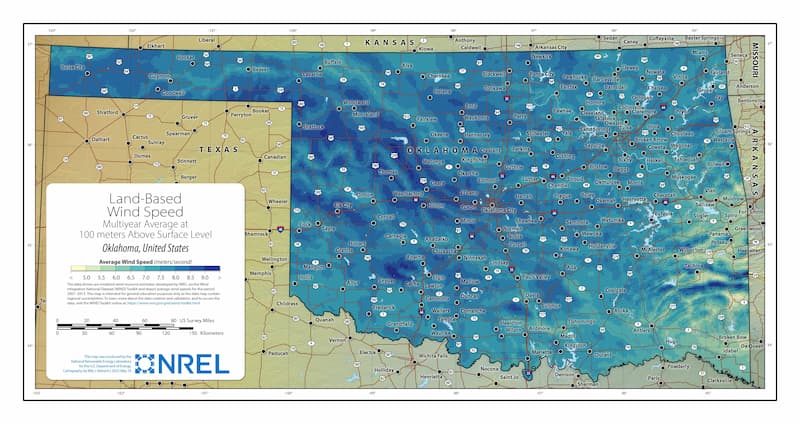
Fexlible but can be tricky
Oklahoma
Oklahoma prohibits wind rights from being severed from the surface estate, but its statutory language is more general than that of Kansas or Colorado. The law was passed amid rapid wind development and reflects a pragmatic approach that leaves room for traditional leasing while discouraging speculative wind interest transfers. It’s flexible but requires careful drafting to avoid title issues.
The Airspace Severance Restriction Act, specifically in 60 O.S. § 820.1, states:
No interest in any airspace over any real property located in this state may be severed from the surface estate, except by a wind or solar energy agreement.
Key Points:
- Severance not allowed: Wind and solar rights cannot be permanently split from the land.
- Leases are allowed: Long-term leases or easements are permitted if recorded.
- Recording required: Any wind energy agreement must be filed with the county clerk.
- Applies to all interests: The law applies to all parties with an interest in the surface estate, not just the current landowner.
Frequently Asked Questions:
Can I sell my wind rights in Oklahoma?
No — wind rights cannot be sold or conveyed separately from the surface.
Can I lease my land for wind energy?
Yes — Oklahoma allows wind leases, but they must be formal, written, and recorded.
Do older agreements still count?
Possibly. Agreements executed before this statute may still be valid, but they should be reviewed by a title attorney to avoid future issues.
Effective Post 2009
North Dakota
North Dakota’s anti-severance statute is concise but notable for applying only to post-2009 agreements. Earlier severed wind interests may still exist, creating potential complications in title chains. The statute aims to prevent the disaggregation of property rights, but its limited retrospective scope may still leave room for confusion in counties where wind development began earlier.
The primary statute governing wind severance is North Dakota Century Code § 17-04-04, which states:
Except for a wind easement created under section 17-04-03 and as otherwise provided in this section, an interest in a resource located on a tract of land and associated with the production of energy for wind power on the tract of land may not be severed from the surface estate.
Wind rights revert to the surface owner if unused:
If a wind easement or lease is terminated or expires and wind energy conversion facilities are not installed within 5 years, the right to develop wind reverts to the surface owner.
Wind rights must be tied to development
The law allows temporary severance through a lease or easement, but only if used for actual wind development. Permanent severance is prohibited.
Recording requirements for transparency
The wind lease or easement must be recorded in the county land records to be enforceable. This ensures transparency and provides public notice of who holds wind rights.
Case example:
In 2008, a landowner signs a document deeding their wind rights to a third party.
In 2011, a developer comes in to lease the land for wind turbines.
Who owns the rights?
Under N.D. Cent. Code § 17-04-04, any agreement attempting to sever wind rights after August 1, 2009, is void. But deals made before that date may still be valid — creating possible title confusion in early wind development regions.
Disclaimer: This overview of North Dakota law is for informational purposes only and is not legal advice.

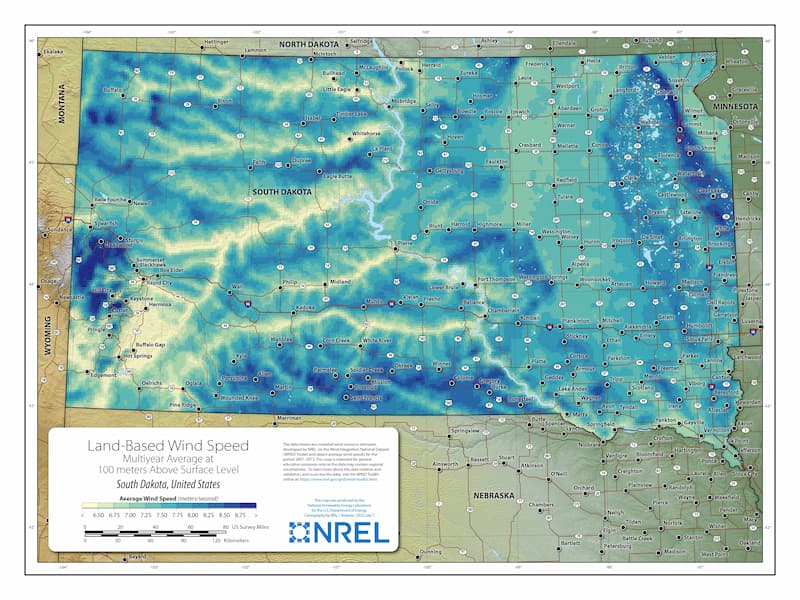
Automatic Termination
South Dakota
South Dakota’s law prevents the severance of wind energy rights and includes a strict deadline: if construction hasn’t begun within five years, the agreement terminates automatically. This provision adds pressure to develop quickly, reducing long-term land encumbrance. Interestingly, the statute defines “commencement” as pouring the turbine foundation — a specificity not seen in many other states.
South Dakota Codified Laws § 43-13-19 states:
“No interest in any resource located on a tract of land and associated with the production or potential production of energy from wind or solar power may be severed from the surface estate, except by a wind or solar energy agreement.”
Non-Severability of Rights
Only the surface owner can grant rights to use the land for wind energy production, and this must be done through a lease or easement for a definite period.
Time-Limited Agreements
Wind energy agreements must be for a definite term and cannot exceed 50 years.
Development Requirement
If no development of the potential to produce energy from wind power has occurred within five years after the lease or easement is executed, the agreement is void.
Definition of Development
Development occurs when the foundation for a wind energy conversion facility is poured.
South Dakota Legislature
Recording Requirements
Wind energy agreements must be recorded with the appropriate county register of deeds to be enforceable against third parties.
South Dakota Wind Development Timeline
| Trigger | Event |
| Agreement signed | Wind energy easement or agreement is executed and recorded. |
| Within 5 years | The developer must begin physical construction. |
| Defined as | Pouring a turbine foundation or similar structural activity |
| Missed deadline | The easement automatically terminates under state law. |
Disclaimer: This overview of South Dakota law is for informational purposes only and is not legal advice.
Automatic Termination
Nebraska
Nebraska’s wind easement law ties energy rights to the land and mandates termination after 10 years if no construction begins. The law emerged during a period of growing wind interest in the Corn Belt and reflects Nebraska’s concern about speculative land locking. It also emphasizes that wind rights cannot be separated or transferred as independent property interests.
Nebraska Revised Statutes § 76-3004 states:
“No interest in any wind or solar resource located on a tract of land and associated with the production or potential production of wind or solar energy on the tract of land may be severed from the surface estate.”
Non-Severability of Rights
Only the surface owner can grant rights to use the land for wind energy production, and this must be done through a lease or easement for a definite period.
Time-Limited Agreements
Wind energy agreements must be for a definite term and cannot exceed 40 years. However, the parties to a wind agreement may extend or renew the initial term by mutual written agreement.
Development Requirement
If development of a wind energy conversion system has not commenced within ten years after the effective date of the wind agreement, the agreement terminates. This period may be extended by mutual agreement of the parties to the wind agreement.
Practical Advice
Nebraska tries to prevent land from being tied up indefinitely. If you inherited land or signed an easement years ago, you may be able to reclaim your full surface rights if no turbines were built.
Tip: A title check or legal review can reveal if you’re still under a valid agreement — or if it expired under the 10-year rule.
Disclaimer: This overview of Nebraska law is for informational purposes only and is not legal advice.
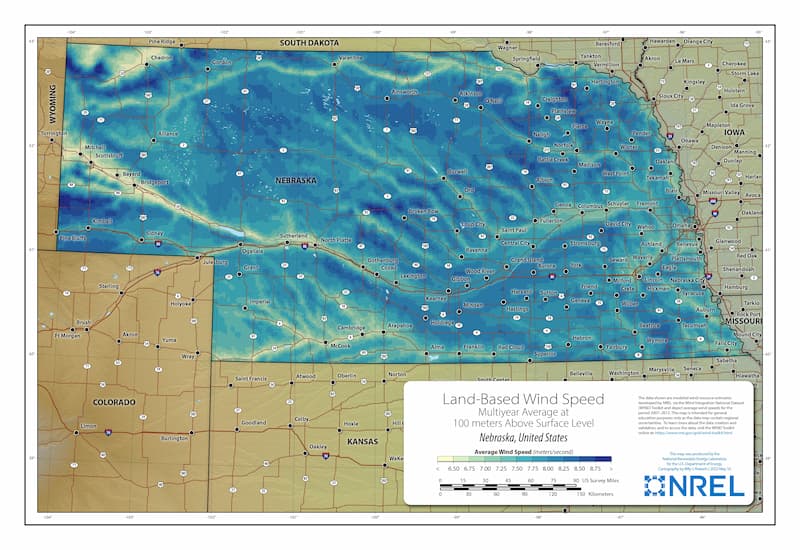
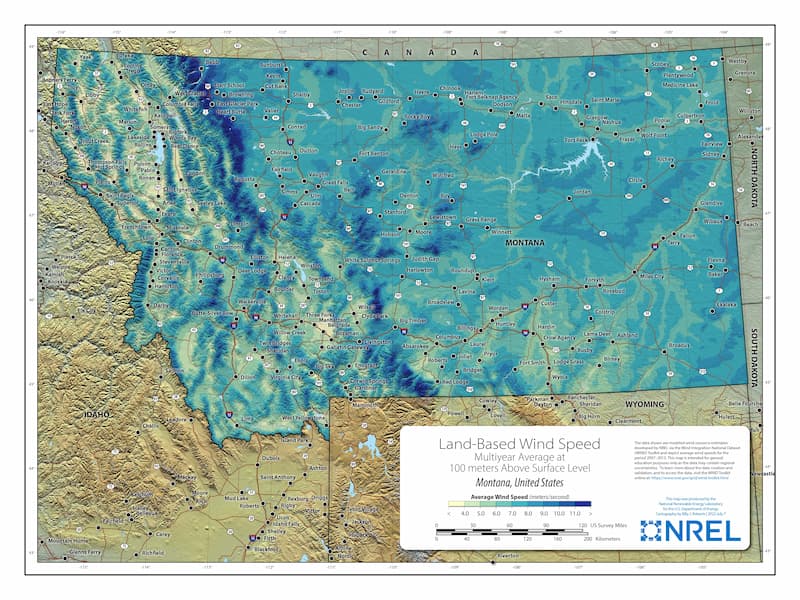
Highly Specific
Montana
Montana prohibits severing wind rights and requires any wind agreement to include highly specific terms — from compensation to liability allocation. Passed in 2011, the law reflects lessons learned from mineral leasing chaos, and even acknowledges the dominance of the mineral estate. Pre-2011 severances are grandfathered in, which could create inconsistencies in older projects.
Montana Code Annotated § 70-17-404 states:
“A wind energy right in the wind resource located on and flowing over the real property, including without limitation a royalty, if applicable, associated with the production of wind energy may not be severed from the real property even though a wind easement may be created pursuant to this part.”
Wind Energy Agreements
Such agreements must include specific provisions, such as the names and addresses of the parties, a legal description of the property, obligations to ensure the undisturbed flow of wind, compensation terms, liability clauses, compliance with laws, and conditions for termination. These agreements must be notarized.
Dominance of Mineral Estate
The statute does not alter the common law principle that the mineral estate is dominant over the surface estate. This means that holders of mineral rights may have certain privileges that can affect wind energy development.
Grandfathering of Preexisting Rights
Wind energy rights created by lease, contract, or other agreement prior to the effective date of the statute, April 21, 2011, remain valid and are not affected by the new provisions.
Disclaimer: This overview of Montana law is for informational purposes only and is not legal advice.
Requires Eventual Release
Wyoming
Wyoming’s statute bans the severance of wind energy rights and requires wind energy agreements to be formally recorded. What sets it apart is its emphasis on reversion — landowners can demand that developers record a release of the agreement after termination. This pro-landowner provision helps prevent outdated filings from cluttering the public record or misleading title searches.
Wyoming Statutes, specifically in § 34-27-103 states:
“(b) Wind energy rights shall not be severed from the surface estate, except that wind energy may be developed pursuant to a wind energy agreement.”
Non-Severability of Rights
Only the surface owner can grant rights to use the land for wind energy production, and this must be done through a wind energy agreement.
Wind Energy Agreements
Such agreements must include specific provisions, such as a description of the land subject to the agreement, and must be recorded in the office of the county clerk where the land is located.
Dominance of Mineral Estate
The statute does not alter the common law principle that the mineral estate is dominant over the surface estate. This means that holders of mineral rights may have certain privileges that can affect wind energy development, so developers may need to purchase or lease the mineral rights before building a wind farm.
Reversion of Easements
After a wind energy agreement has terminated, the surface owner may request the wind energy developer to record a release of the agreement. If the developer fails to do so within 20 days, they may be liable for damages.
Disclaimer: This overview of Wyoming law is for informational purposes only and is not legal advice.
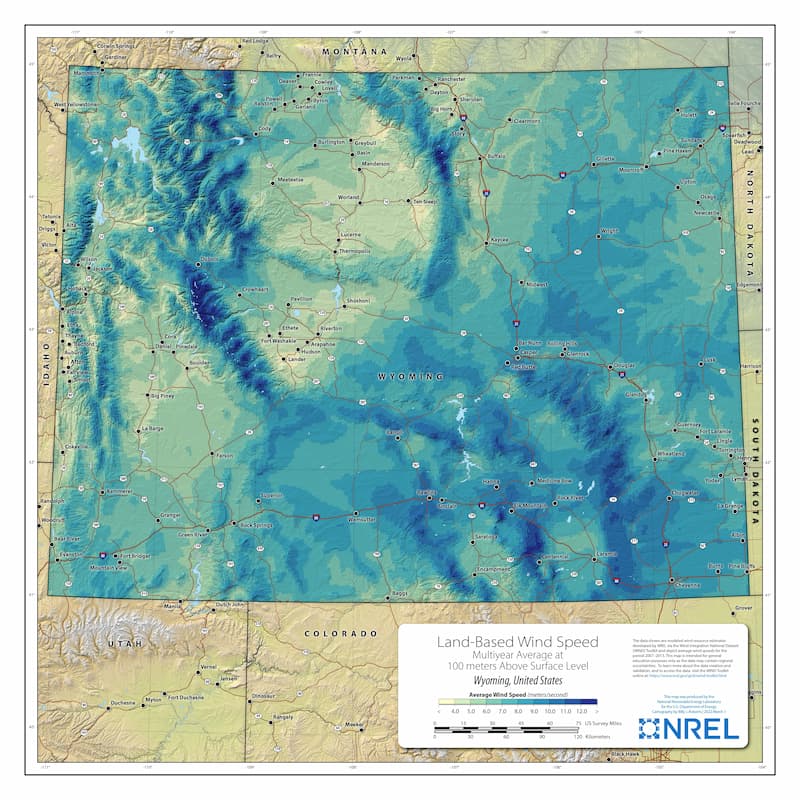
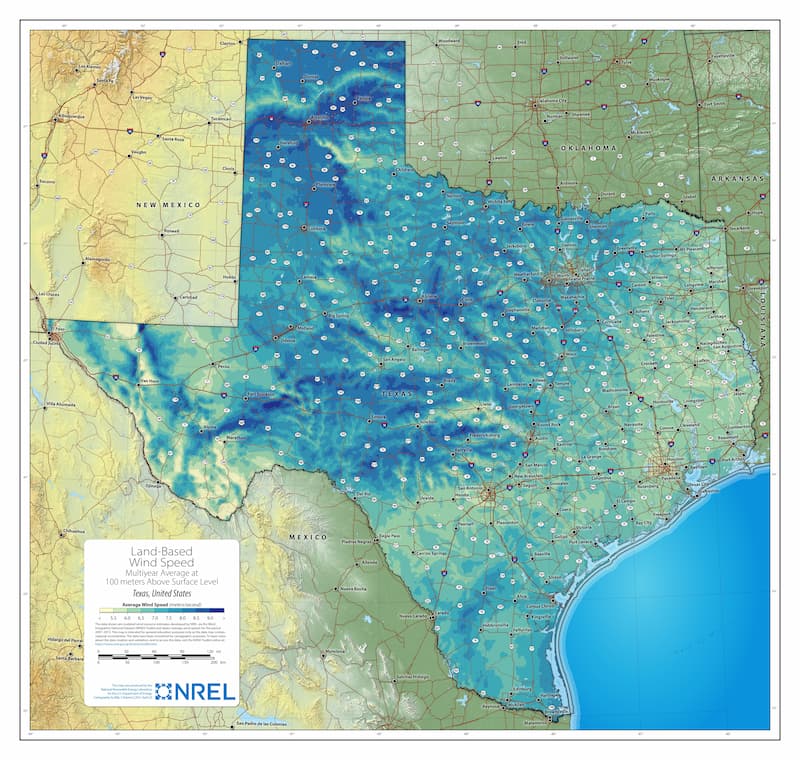
The Exception
Texas
Texas does not prohibit severance and may implicitly allow it under property law traditions (especially given its mineral law legacy). One court has acknowledged the severability of wind rights, but it remains unsettled by statute.
A district court in Hale County, Texas, determined that wind rights can be severed from the surface.
Ridge Renewables, LLC v. Southwestern Public Service Company
Ridge Renewables acquired wind rights previously reserved by a landowner. When Southwestern Public Service Company developed wind turbines on the property without compensating Ridge Renewables, the court found that Ridge held the exclusive wind rights and that SPSC had trespassed in bad faith. The jury awarded Ridge over $1 million in damages.
This decision marks the first time a Texas court has recognized wind rights as a severable property interest. However, the case is currently pending before the Amarillo Court of Appeals (as of May 27, 2025).
Weighing Risks and Benefits
Risks Associated with Wind Energy Rights
Unlike oil and gas royalties, which deplete over time, wind farm leases, easements, and other accommodation payments often escalate over time (to keep up with inflation). So, why would a landowner sell the royalties (or participation/accommodation agreements)? It turns out there are several significant risks associated with wind royalties.
Repowering
The biggest risk is a partial or full repowering. Wind turbines are mechanical and often need to be repowered after 8-13 years. In 2025, Trump halted the permitting of wind energy permits, which impacts new and current projects.
Inflation
Many wind easements, royalties, and accommodation agreements fail to account for inflation (or cap inflation), making the payments less valuable over time. This is a higher risk during times of higher inflation, such as seen in 2021-2023.
Wake Effects
Additional nearby wind development may introduce wake effects, reducing turbine production and potentially causing it to be moved or removed.
Contract Terms
Wind agreements usually favor the developer/operator and some can be canceled by the operator at any time. Future revenue may not be guaranteed, even if the wind project remains operational.
Greenfield Development
Incentives, such as Investment Tax Credits (ITC), county tax abatements, and others, incentivize new development in a “greenfield” rather than repowering or extending the current lease agreement. In 2025, the Big Beautiful Bill (OBBBA) eliminated tax incentives for wind energy development.
Political Climate
The political climate can encourage or discourage wind development, and either can have a negative impact on your wind compensation payments. In the summer of 2025, Trump halted the wind energy permits, which impacts both new development and repowering of current wind projects.
Sell Your Wind Energy Rights (Request an Offer):
Unlock You Future Value
Sell Your Wind Royalties
(Or other Wind Compensation or Accommodation Payments)
Wind royalties used to demand a premium of 6-9 years’ cash flow, but the market has since cooled. An offer of 3-6 years is much more common now.
Whether you are closer to 3 years or 6 depends on a variety of factors, including the annual revenue, lease terms, esclation clauses, age of wind turbines, risks, and more.
Which states specifically allow a wind estate to be severed from the surface?
While no state specifically allows the wind energy resource, as a property right, to be severed from he surface, Texas might be the first. In a recent case, a Texas District Court allowed for the severance of the wind estate, based on existing oil and gas mineral law. That case is going through the appeals process.
No other state appears close to allowing wind severances.
6. Can wind rights be inherited or gifted separately from the land? In most anti-severance states, no — they follow the surface estate. Call out exceptions or gray areas.
In most states with anti-severance statutes, wind rights cannot be inherited, gifted, or otherwise transferred separately from the surface estate. These laws treat wind energy potential as an incidental use of the land itself, not as a standalone property interest. That means any attempt to transfer wind rights apart from the land — whether through a will, trust, or deed — is typically void or unenforceable.
So, what does this mean?
If a landowner tries to leave “the wind rights” to one heir and the land to another, the transfer likely fails under state law.
Even if recorded, such documents may not hold up — especially in Kansas, Colorado, South Dakota, and Wyoming, where wind rights are statutorily tied to the surface.
Exception: Pre-existing severances
Some states (e.g., Montana) allow severed wind rights if they were executed before a certain cutoff date (May 10, 2011, in Montana). These “grandfathered” agreements may still be valid and transferrable as separate property interests.
Key Takeaway
If you inherited land and believe someone else holds the wind rights, or vice versa, it’s wise to review the recorded documents and consult an attorney familiar with your state’s wind statutes.
Note: Wind leases or easements are still valid legal agreements, but they don’t create a separate, inheritable wind estate unless they predate anti-severance laws.
Can I sell my wind royalties separately from the underlying wind estate?
Yes, wind royalties, easements, and accommodation payments are often conveyed without transferring the underlying land-use rights. In fact, many states do not allow the severance of wind rights from the surface.
Can I sell my wind royalties separately from the underlying wind estate?
Wind severance refers to legally separating the wind rights from the surface ownership of the land, similar to how mineral rights can be severed. In contrast, wind royalties are payments made under a contract (usually a lease or easement) when a wind project is developed on the land.
| Wind Severance | Wind Lease, Easement, Royalties, and Accommodation Payments | |
| What it is | Legal ownership of the Wind Development rights | Income stream from a lease, easement, rent, royalty, or other agreement |
| Type of interest | Real property (if allowed) | Personal property (a contractual right) |
| Can it be sold? | Not allowed in most states | Often allowed, but depends on the contract |
| Contract required? | Not necessarily – severance can exist without active use | Yes – payments only exist if turbines are built |
| Subject to anti-severance laws? | Yes | No – most payments exist due to an agreement. |
